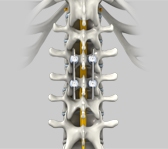Spinal Fixation and Fusion

Spinal Fusion with Instrumentation
Spinal Fusion is a surgical technique in which two or more vertebrae are joined with the help of bone grafts and/or instrumentation. During spinal fusion a piece of bone (bone graft), taken from another bone of the body or from a bone bank, is placed between the adjacent vertebrae. During the healing process, the graft fuses with the vertebrae leading to the formation of a solid mass of bone which stabilizes the spine.
Spinal instrumentation is a method of stabilizing the spine after fusion with the help of implants such as rods, plates, screws, and interbody devices. These spinal devices and implants firmly hold the vertebrae together, during the healing process.
Spinal fusion permanently joins two or more vertebrae and the instrumentation stabilizes the spine after surgery. Common surgical procedures that involve spinal fusion and instrumentation include:
- Anterior Lumbar Interbody Fusion (ALIF)
- Posterior Lumbar Interbody Fusion (PLIF)
- Transforaminal Interbody Fusion (TLIF)
- Direct Lateral Interbody Fusion (DLIF)
- Axial Lumbar Interbody Fusion – AxiaLIF
- Anterior Cervical Discectomy
Spinal fusion and instrumentation may be performed to treat spinal instability caused by some spinal conditions or surgical procedures. Spinal fusion may not always be successful; its success is based on your body’s ability to heal and produce new bone. Your general health including co-existing conditions such as diabetes, endocrine disease, and osteoporosis may also affect healing. Your doctor may recommend specific tests to evaluate your medical condition. If you have a pre-existing health condition, you can follow certain measures to reduce the risk of fusion failure:
- Stop cigarette smoking or tobacco use
- Eat a healthy and nutritious diet to fuel the body during the healing process
- Exercises must be performed during your recovery, to enhance the healing process
- Get plenty of rest after surgery
Follow your surgeon’s instructions to increase your chances of a successful outcome. Talk to your surgeon about any concerns on spinal fusion with instrumentation.

